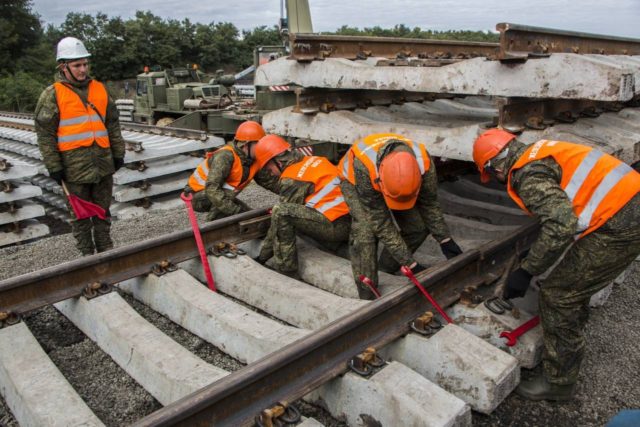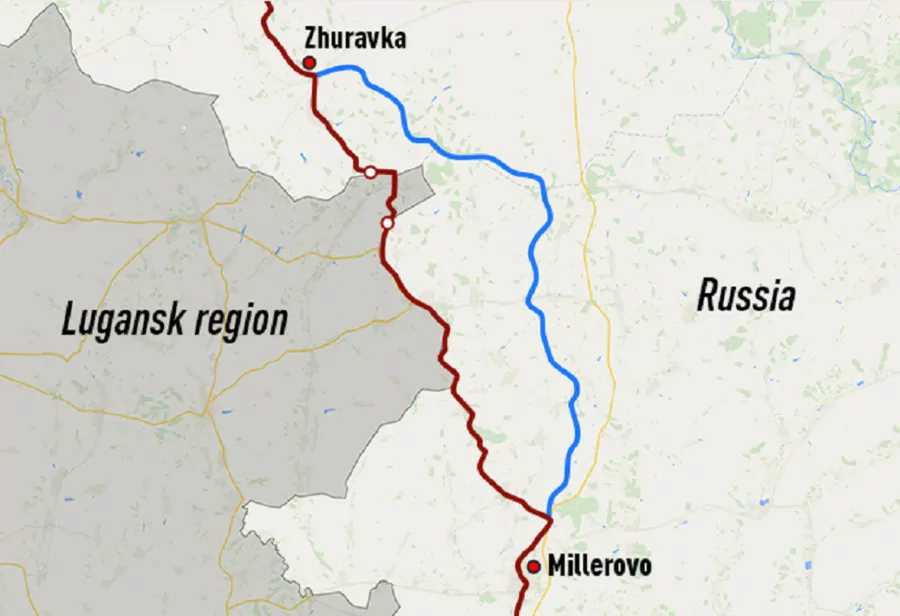
Zhuravka–Millerovo Rail Bypass: A Threat to Ukraine’s National Security?
Publication: Eurasia Daily Monitor Volume: 14 Issue: 98
By:

Russian media announced, on July 14, that the new (122.5-kilometer) railway connection between the southwestern Russian towns of Zhuravka and Millerovo will be completed by mid-August (Rzdp.ru, July 14). Originally, these two cities were linked by a Soviet-era railroad that, in part, crosses eastern Ukraine. But following Russia’s invasion of Donbas in early 2014, Kyiv shut down this portion of the border, thus severing the rail line. Aiming to bypass Ukraine, Moscow launched the new Zhuravka–Millerovo rail project in November 2014. Aside from the railway itself, the project envisages the creation of 98 new infrastructure elements, including bridges, highways and seven brand new railroad stations along the way (Uvzd.rzd.ru, January 19).

Initially, few Western observers paid significant attention to the project. Those who did, however, expressed doubts that the initiative would be completed as planned due to issues with funding, notorious Russian corruption and lack of discipline (see EDM, October 5, 2015; November 25, 2014). Perhaps those predictions would have proven correct if the project was driven solely by civilian considerations. But judging by the pace of work, the sum of the allocated funds, the political determination and the devoted manpower, it seems that the initiative occupies a much more prominent place in Moscow’s strategic and military thinking than heretofore recognized.
Notably, when the project was first introduced, the deadline was set for 2018, with the main bulk of construction work to be carried out by Russian Railways (RZD) (RIA Novosti January 29). Yet, starting from 2016, the level of involvement of the Russian military forces increased exponentially. On April 20, 2016, Russia’s First Deputy Defense Minister Ruslan Tsalikov admitted the Army was involved, noting that “if required, the Railway Troops could assist RZD to an even greater extent” (Tvzvezda.ru, April 20, 2016). On November 26, Russian Deputy Defense Minister General Dmitry Bulgakov bestowed awards to 23 members of the Railway Troops for their “high personal input in the construction of the railway bypassing Ukraine.” Lieutenant Colonel Valery Efremov was awarded with the Order of Honor and Lieutenant Colonel Alexey Mishurin received the Order for Military Merit. The rest received medals For Merit to the Fatherland (Second Class) and Medals of Suvorov. During the ceremony, General Bulgakov emphasized that the commander-in-chief of the Armed Forces (President Vladimir Putin) and the minister of defense (Sergei Shoigu) “highly appreciate your professionalism and determination in building the Zhuravka–Millerovo railway, which is of instrumental importance for Russia” (Interfax, November 26, 2016).
Subsequently, on May 30, 2017, during the official inspection of the construction area, Bulgakov stated that “at this point, 97 percent of grading work has been completed.” He also underscored that more than 1,000 Railway Troops and 500 units of special equipment were involved in the construction (Vpk.name, May 30). Similarly, representatives of RZD claimed that the project currently involves 2,500 civilian construction workers, supplemented by 1,500 pieces of technical equipment (Interfax, January 28). Impressive as it might seem, this could still be just a small fraction of the total forces potentially diverted to the needs of this railroad. Recent information suggests that the Zhuravka–Millerovo bypass is merely part of bigger project aimed at completely renovating the railroad connection between the Privolzhsky region (western-central Russia) and the Azov/Black Sea basin, with the deadline set for 2019 (Gudok.ru, February 12).
In spite of Moscow’s official claims that the Zhuravka–Millerovo bypass had to be built to reconnect internal portions of Russia cut off since 2014 due to the aggravated relations between Moscow and Kyiv and the outbreak of the military conflict in Donbas, many experts are increasingly questioning the railroad’s true strategic objective. For instance, Olga Aivazovska, a member of the Ukrainian delegation to the Minsk peace talks (since 2016), linked the railroad to other anti-Ukrainian measures recently introduced by Moscow, such as the Russian government’s recognition of passports presented by the Donetsk and Luhansk “People’s Republics.” According to the expert, Russia’s goal is to develop “economic, logistical and political connections that will (if not integrate this territory into Russia) allow the area to neither perish nor fully return under Ukrainian sovereignty” (Tvzvezda.ru, February 28).
Prominent Russian military expert and analyst Pavel Felgenhauer ascribed the construction of this railroad to Russia’s broader military goals in the region. At this juncture, the construction of the bypass is indispensable for the Russian side to be able to transport troops to the Ukrainian border. According to the expert, this could mean that the Kremlin is creating a solid foundation for a potential military offensive against Ukraine. Given the fact that Russia has already established four military bases in Briansk, Belgorod, Voronezh and Rostov oblast, infrastructure-related issues in this area are gaining pivotal importance. However, Felgenhauer suggested that the finalization of the construction work in August would not necessarily imply an imminent outbreak of heavy hostilities between Russia and Ukraine. Rather, the completion of the railroad bypass should mainly be seen as “preparation of the theater for future conflict” (Fakty.ictv.ua, March 2).
Once the Zhuravka–Millerovo rail bypass is complete, it is highly probable that the two reconnected areas of Rostov Oblast that border Ukrainian Luhansk will find themselves completely cut from the outside world—prompting locals to abandon the region en masse. The local media attempted to highlight this issue back in 2015, but the discussion was immediately hushed up by the authorities (Aif.ru, May 20, 2015). The prospect of this Russian border area turning into some sort of no man’s land almost completely devoid of a civilian population does not appear to worry Moscow, however. This appears odd, unless of course that is in fact part of the Russian government’s plan for the region.
In recent days, international observers reported seeing increased concentrations of Russian heavy military equipment in Novoazovsk, close to the Chisinau–Rostov highway (Hromadske.ua, July 22). Such news bolsters the case that the Zhuravka–Millerovo railroad bypass in fact constitutes a tangible threat to Ukraine’s national security. Once it completes this transit line, Russia will be in a position to link the Azov/Black Sea with other parts of Russia, connecting the Western and Southern Military Districts. This enhancement of Russia’s internal transportation network in the southwest will allow Moscow to more quickly and easily create a springboard for a potential major military offensive against Ukraine and threaten the entire Black Sea region as a whole. For many Black Sea littoral states—Ukraine first and foremost—these developments look particularly worrisome considering the upcoming large-scale Zapad 2017 military exercise, which will be held in western Russia this September.



